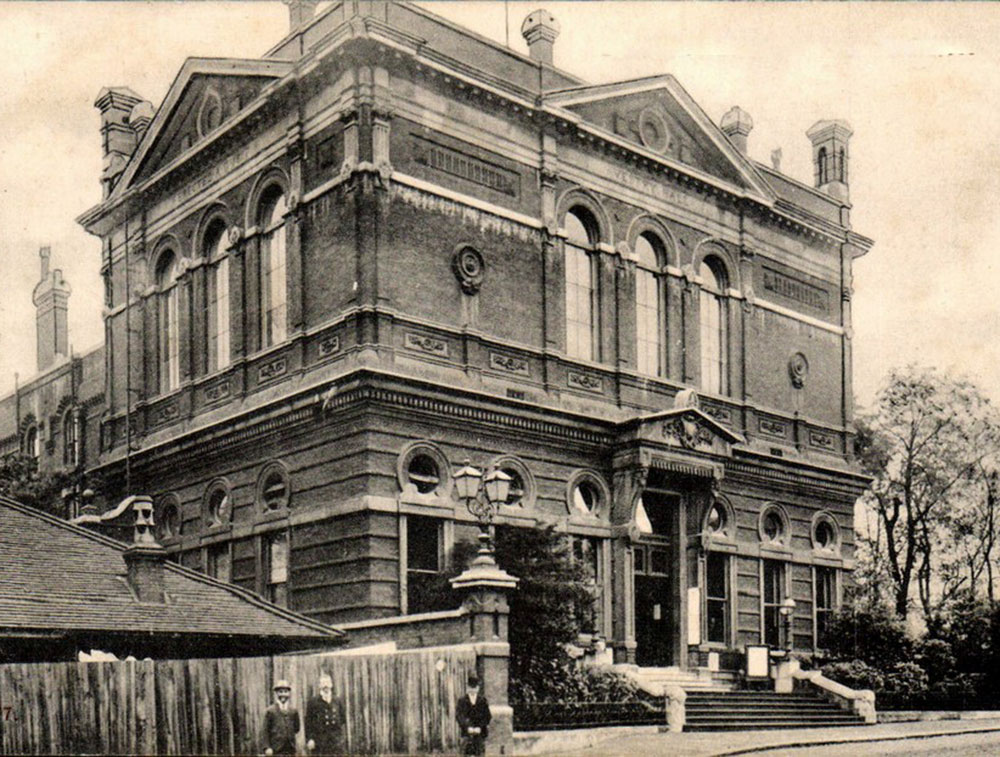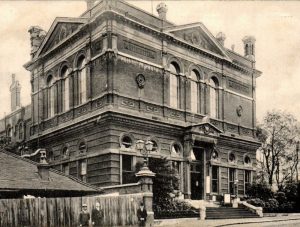It has hosted countless musicians, with the band that became Madness playing an early concert here and the Pogues using the building to stage a benefit gig for the Miners in 1985.
As well as being the seat of council, the Hall has seen radical political action: in 1913 Emmeline Pankhurst gave an impassioned speech for the suffragette movement here, the content of which survives in the National Archives today because an undercover policeman in attendance took covert notes and reported them back to his superiors. In the 1930s, Belsize Park was sadly a centre of fascist activity, which was well resisted by a number of co-operating community groups; so much so that when Lord Haw Haw and Mosley spoke at the Town Hall during that decade, their meetings were repeatedly protested, with one 1938 event seeing large numbers of women arrested and reports of ‘hand to hand fighting’. In the 1959 General Election, the great anti-racist campaigner David Pitt (later Lord Pitt, Baron of Hampstead) stood for Labour here, delivering a wonderful speech on the steps of the Town Hall, despite being heckled throughout by the National Front.
During the Second World War, the Town Hall became a North London centre of Air Raid Precautions, with its panoramic view over London proving indispensable in locating where bombs where dropping and directing emergency relief therefore saving many lives. The lookout and the phone centre (which took over 600 calls during the War) was manned 24 hours a day by local volunteers, including the famous Jamaican writer and feminist Una Marson (who was also the first black producer at the BBC) who worked here as an air raid warden ‘in her spare time’. The Town Hall itself took three direct hits during the war, with the campanile (bell) tower being partially destroyed as a result.
As a civic centre, the Hall was used to register thousands of births and deaths and of course acted as a marriage venue, with the superstar ‘the One, the Only, the Beloved Queen of Music halls’ Marie Lloyd marrying here in 1907. Her funeral in Hampstead in 1922 attracted 100,000 mourners, and super-fan TS Eliot declared he wouldn’t socialise for two months because he was grieving. Eliot himself married his first wife Vivienne Haigh Wood here in 1915. Other people wed here include Judi Dench, Cleo Laine, Dudley Moore, Lulu and the sculptor Barbara Nicolson. On screen, the wedding in Georgy Girl was filmed here, as was a scene from Four Weddings and a Funeral.
Hampstead Old Town Hall: A Timeline of Change-Making
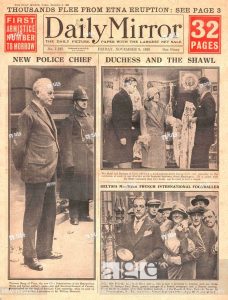 1878 Victorian Building completed. Called “Hampstead Vestry Hall.”
1878 Victorian Building completed. Called “Hampstead Vestry Hall.”
1910 Edwardian extension. Building renamed “Hampstead Town Hall.
1912 Fund raiser for victims of the Titanic.
1913 14th February Women’s Suffrage meeting hosted by Emmeline Pankhurst, her speech is recorded by undercover policeman (see post box damaged by suffragettes in 1914 by a smoke / tar bomb, north side of Hampstead High Street (#23) , junction with Gayton Street): “And I want you not to see these as isolated acts of hysterical women, but to see that it is carried out on a plan and that is being carried out with a definite intention and a purpose. It can only be stopped din one way. That is by giving us the vote.” (see National Archives, HO 45 / 10695 / 231366).
1931 Imperial Facist League (IFL) meets at HTH
1932 (May) Town Council bans letting of Hall to IFL, but continues to rent space to the British Union of Facists – weekly protests from radical anti-facist groups take place throughout 1930s
1936 (Oct) William Joyce (Lord Haw Haw) addresses meeting of British Union of Fascists, 22nd October. Police break up hand to hand fighting. Tuesday 03 November, five hundred people protest against the meeting, including many women: “One steward full fistedly grabbed a girl by her hair and literally tore her out of her seat. Another girl lost her shoes in the struggle” (David Stephen Lewis, Illusions of Grandeur: Mosley, Facism and British Society p126); also see “Women Fight at Facist Meeting”, Morning Post 23 Oct 1936
1936 – Patrick Devine and Patrick Dooley (who gave local artist Cliff Rowe – https://www.tate.org.uk/art/artworks/rowe-street-scene-kentish-town-t12448 – a copy of the Communist Manifesto) hold a rally in the Old Town Hall to encourage the community to go to fight against Franco, Devine recites the speeches of James Connolly to the crowd, in what what described as a “packed meeting” (Irish Press, 1 Aug 1936, p 12).
1937 – For every Sunday in ’37, the British Union of Facists march to and from Belsize Park tube > Hampstead Heath
1939 – 1945 Becomes Centre for Home Guard. Probable / possible interrogation centre for “enemy aliens” Bunker graffiti still visible – we are looking at black Briton’s who took part in the Home Guard and their connections to Hampstead Town Hall (f we are looking at WW2, there is plenty of stories about black members of RAF (colour ban until 1941?), army etc – also black children evacuated from London – history of this not taught in schools nor made visible when we talk about the Second World War).
1940s Radical african students – later radical politicians – live in Hampstead (look for links to Town Hall) e.g. Joe Appiah (part of the WASU “Primrose Gang’, 37 Primrose Gardens), Kwame Nkrumah (see https://wasuproject.org.uk/introduction/)
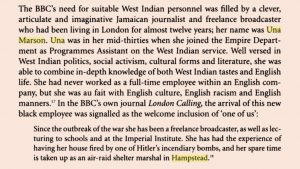
Nationalising Femininity: Culture, Sexuality and Cinema in World War Two Britain edited by Christine Gledhill, Gillian Swanson, p.124; cf London Calling , no. 80, 13-19April 1941 p13 (NB there is a Haile Selassie connection to Una M and Hampstead – Beth to research this – cf Delia Jarrett-Macauley’s The Life of Una Marson, 1905-1965, p102)
1946 – photo of a dance at Old Town Hall, people in fabulous costumes, and half the men and women in the photo are BAME
c. 1948 onwards Women from West Africa, training as doctors at the Royal Free, sit their board exams in Hampstead Old Town Hall (also Indian women doctors trained at RF – we will work with the hospital to uncover more information e.g. about Hilda Bynoe, nee Gibbs, a cousin of David Pitt).
1953 – Nigerian Womens’ League founded, launched New Years Day with a dance at the Town Hall “We believe that the women of Nigeria are capable of following in the courageous footsteps of the many brave men of other lands who have in the past fought against prejudice and overcome overwhelming obstacles in achieving great victories in the field of human endeavour….ours is the cause of Nigerian womanhood.” (Marc Matera, Black London p 118).
1959 – David Pitt stands for Labour in Hampstead district in Parliament, becoming the first West Indian to seek a seat in Parliament. Gives speech on Town Hall steps, racist movement tries to disrupt:
Pitt’s election campaign was of course taking place against the outcome of the 1958 Notting Hill riots. Pitt’s son Bruce recalled for me death threats made against the family during the campaign; together with a bookmaker offering odds of five to one against his father living through the election. Meanwhile, Oswald Mosley had returned to Britain to stand for the London constituency of Kensington North on a platform of anti-immigration, calling for forced repatriation of Caribbean immigrants. Pitt’s campaign was a natural target and Mosley marched on Hampstead, leading to what became known locally as the “Battle of Hampstead Town Hall”. And, as if that was not enough, the building housing Pitt’s surgery was firebombed.
http://jennettearnold.com/wp-content/uploads/2014/09/Echoes-A5-red.pdf
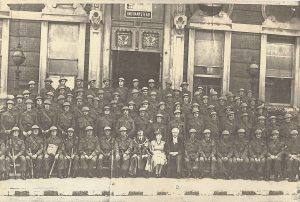 1964 – Town Hall hosts the exhibition “Spain Fights For Freedom!” on Hampstead and the International Brigades in the Spanish Civil War (c.f. Marx memorial library)
1964 – Town Hall hosts the exhibition “Spain Fights For Freedom!” on Hampstead and the International Brigades in the Spanish Civil War (c.f. Marx memorial library)
1966 The first Durga Puja celebration – which continues to this day.
1969 The Scratch Test Orchestra play their first gig at Hampstead Town Hall (1/12/69)
1971 Sat Dec 2nd Gay Liberation Front disco.
1977 Suggs sings first gig with the band that were to become Madness.
1985 Friday 11 Jan, 7.30pm, The Pogues play to fundraise for the National Union of Mineworkers.
1986 Independent activists hold a Belgrano Inquiry at Hampstead Town Hall: http://belgranoinquiry.com/contact
